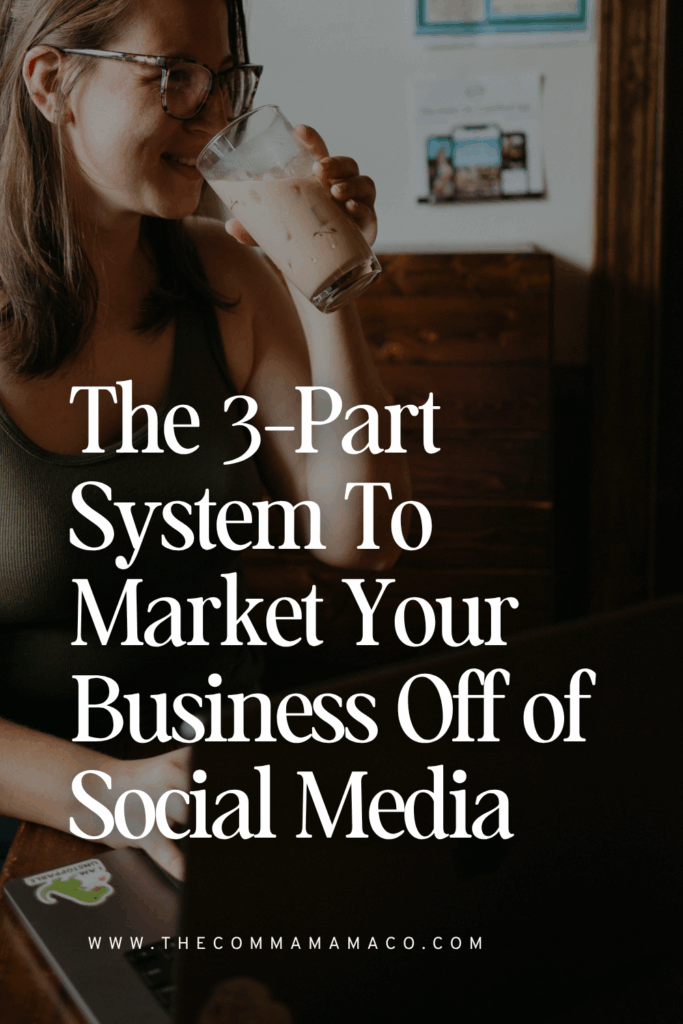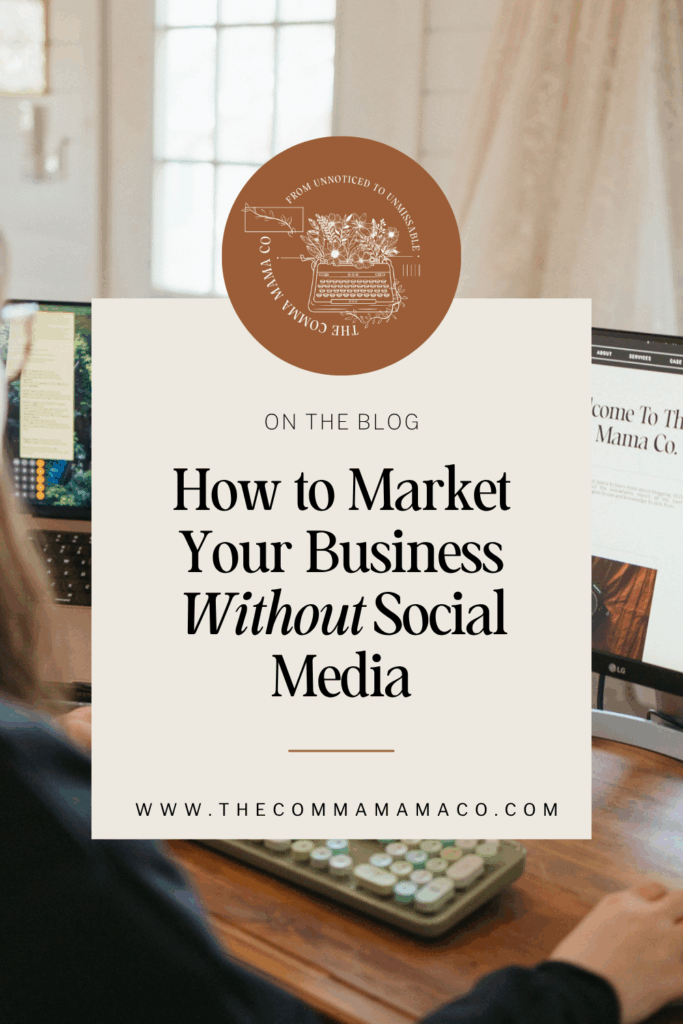I have a love for words and a knack for SEO – and as a mama, I know just how challenging it can be to run a business while raising a family. This blog is just one of the many resources you’ll find here that’ll help you boost your online visibility without sacrificing your sanity.
Thanks for being here (and I hope you’ll stick around).
Mckayla
categories
blogging
seo
Business
stop getting ghosted by gogle
download now
explore
case studies
to the shop
work with us
follow us on instagram
share
If you’re feeling utterly exhausted by social media or constantly worried about what happens if you misstep and get banned from your main platform (looking at you, TikTok), you’re not exactly alone.
When you rely solely on social media to make sales—even if it’s the platform that built the business you have today—you’re putting all your eggs in one basket. And that basket also happens to be sitting pretty precariously on a random tree branch.
What happens when it falls? Everything goes to sh*t (or rather, it’s a huge mess and you’re left picking everything up AND trying to figure out how you’ll keep your business afloat).
The reality is that learning how to market outside of social media isn’t just a “nice to have” strategy—it’s a must for building a sustainable business that thrives even when algorithms change, platforms crash, or entire apps face uncertain (or certain?) doom.
Psst… listen to post on the Social Media Optional podcast here:
Why Marketing ONLY on Socials Doesn’t Work (At Least, Not Long Term)
The past few years have been one heck of a wake-up call about platform dependency. If you’ve built your business primarily on TikTok, you might have noticed buyers becoming hesitant to purchase when the platform’s future looked sketchy at best.
If Instagram is your main source of traffic, you’ve probably felt that pit in your stomach when it crashes for a day and you’re left thinking well, shoot.
Here’s the thing: you don’t really own any digital property on these platforms. When a platform crashes and you can’t log in or post what you planned, you’re suddenly reminded just how much you’re at the mercy of forces outside your control.
It’s like renting an apartment and then your landlord decides to demolish the building with zero notice.
This vulnerability applies beyond social media, too. What happens if your email service provider malfunctions? What if a Google algorithm update tanks your carefully built SEO rankings overnight? What if new regulations affect how your emails are delivered?
These platforms and tools are exactly that—tools. They can break, become outdated, or require support from other systems to function properly. Instead of trying to find the “perfect” platform to own completely (spoiler alert: it doesn’t exist), you need to focus on what you can actually control.
What You Can Control in Your Marketing Strategy
The good news is that there’s plenty within your control when you know how to market outside of social media effectively (and without wanting to throw your laptop out the window):
- Platform selection: You choose which channels align with your strengths and audience
- Content workflows: You develop systems that work across multiple platforms
- Diversification strategy: You spread your efforts across different types of marketing
- Backup plans: You create systems that support you when one platform fails
- Consistency: You show up regularly where it matters most
The goal isn’t to stress about every possible platform failure, but to create a marketing ecosystem that can comfortably survive a day, a week, or even a month without depending on any single channel.
The Foundation: Your Website as Home Base
When exploring how to market outside of social media, your website should be your starting point and anchor. This is your true digital real estate—the one place online that you actually control.
Your website needs to work harder when you’re not relying heavily on social media. You’ll want to focus on SEO optimization to attract organic search traffic, clear messaging that converts visitors into clients, strong branding that builds trust and recognition, and a user experience that guides people toward your offers without making them feel like they’re navigating a maze.
Think of your website as the hub where all your other marketing efforts ultimately point. When someone discovers you through any channel, your website is where they’ll go to learn more and make decisions about working with you.
How to Start Marketing Outside of Social Media: The Three-Platform Approach
You don’t need to be everywhere, but you do need to be strategic about where you show up.
Here’s a simple starting approach for how to market outside of social media while still maintaining some social presence:
Pick One Social Platform
Yes, you can still use social media as part of a diversified strategy. The key is choosing one platform and doing it well rather than spreading yourself thin across multiple social channels like some kind of content creation martyr.
Whether that’s Instagram, Facebook, LinkedIn, or even emerging platforms like Threads or Bluesky, commit to showing up consistently in one place.
Choose One Long-Form Channel
Long-form content has staying power that social media posts simply don’t (shocking, I know). Consider these options:
- Email marketing: Build a list you can nurture directly
- Blogging: Create searchable, evergreen content (this is a personal fave)
- Pinterest: Tap into visual search traffic (did you know I was a Pinterest manager is a past life? It’s easy to set up an account, AND Pinterest helps your SEO).
- YouTube: Reach audiences through video content (this is one I’m currently testing with the help of YouTube Program).
- Podcasting: Build deeper connections through audio (another personal FAVE, hence the Pod to Blog™ program!!)
Also, each platform can have its own purpose. So while you may be repeating your message (as you should), one platform can be more awareness-driven, while others are educational.
Don’t Forget Email
Email deserves special mention because it’s the bridge between all your other marketing efforts. Every other channel should be working to build your email list, giving you a direct line to your audience that doesn’t depend as much on algorithms or platform policies.
Alternative Strategies When You Want to Skip Social Entirely
If you’re truly ready to learn how to market outside of social media completely (and honestly, good for you), you can focus on two long-form channels instead. This approach requires understanding that your client acquisition will look different, but it’s absolutely possible.
Consider combinations like SEO plus email marketing where you attract through search and nurture through email, or Pinterest plus blogging for visual discovery leading to valuable content. You might also try podcasting with email for audio connection plus direct follow-up, or YouTube with email for video content and list building.
The key is accepting that your marketing timeline might be longer, but your connections will often be deeper and more qualified. Plus, you won’t have to deal with the constant algorithm anxiety.
Moving Forward Without Platform Panic and Making Your Business a Little Less Social Media Reliant
The most liberating part of diversifying how you market outside of social media is the peace of mind it brings. When you’re not dependent on any single platform, you can approach each channel as an opportunity rather than a life-or-death necessity.
Algorithm changes become less scary (they’re still annoying, but manageable). Platform outages become minor inconveniences rather than business emergencies that have you stress-eating at 2am. You gain the freedom to experiment, pivot, and grow without the constant fear of losing everything overnight.
Remember, the goal isn’t to be everywhere—it’s to be strategic, consistent, and resilient. Pick your channels, show up regularly, and build systems that support your business growth regardless of what’s happening in the ever-changing (and honestly, exhausting) world of digital marketing.
Your business deserves a marketing strategy that’s as reliable and multifaceted as you are. Start building yours today, and maybe you’ll be able to sleep through the night without checking if Instagram is down again.
Ready to start building your foundation? Download this free SEO checklist for business owners and get access to six different things you can do to improve your SEO in 15 minutes or less.
Psst… Don’t Forget to Pin it!


Reader Etiquette
© - Content and images in this blog are copyright this blog unless stated otherwise. Feel free to repost or share images for non-commercial purpose, but please make sure to link back to this website and its original post.
℗ - We do not store any information about your visit to our website other than for analytics and optimization for content and reading experience through the use of cookies.
c/o - Our site does at times contain paid advertisements, sponsored content, and/or affiliate links.
You might want to check these out too while you're at it
FREE Guide:
6 Simple Steps For Better SEO
INSTANTLY IMPROVE YOUR GOOGLE RANKING
Want to improve your website SEO in one afternoon? This free resource offers 6 actionable steps you can take in 15 minutes or less to instantly improve your SEO.
download now
categories
blogging
SEO
business
It's me, hi! Your SEO bestie.
get to know me
work with us
//
services
//
case studies
//
Mom of three, lover of all things blogging, and borderline obsessive coffee drinker — I also just happen to love making complicated things simple and accessible, especially when it comes to SEO. The blog is a collection of what I've learned from years of testing, trial and error, and working with amazing clients with impactful businesses (just like yours). Blogging and SEO doesn't have to be boring — and it definitely doesn't need to be difficult.



